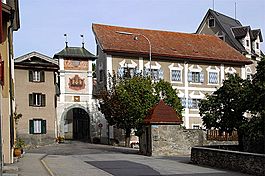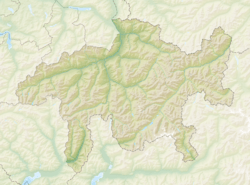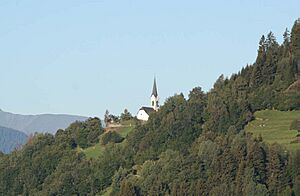Ilanz/Glion facts for kids
Quick facts for kids
Ilanz/Glion
|
||
|---|---|---|
 |
||
|
||
| Country | Switzerland | |
| Canton | Graubünden | |
| District | Surselva | |
| Area | ||
| • Total | 133.48 km2 (51.54 sq mi) | |
| Population
(Dec 2020 )
|
||
| • Total | 4,797 | |
| • Density | 35.938/km2 (93.079/sq mi) | |
| Postal code |
7130
|
|
| Localities | Ilanz/Glion, Strada, Castrisch, Ladir, Luven, Pitasch, Riein, Ruschein, Schnaus, Sevgein, Duvin, Pigniu, Rueun, and Siat | |
| Surrounded by | Schluein, Sagogn, Safiental, Vals, Lumnezia, Obersaxen Mundaun, Waltensburg/Vuorz, Andiast, Glarus Süd (GL) | |
Ilanz/Glion (pronounced EE-lants in German and lyon in Romansh) is a town in the Swiss canton of Graubünden. It's a special kind of municipality in the Surselva Region. On January 1, 2014, many smaller towns like Castrisch, Ilanz, Ladir, Luven, Pitasch, Riein, Ruschein, Schnaus, Sevgein, Duvin, Pigniu, Rueun, and Siat joined together to form the new, bigger municipality of Ilanz/Glion.
Contents
A Look Back: The History of Ilanz/Glion
How Old Are These Towns?
Many parts of Ilanz/Glion have been around for a very long time! For example, Ilanz was first mentioned in records way back in 765. Other places like Ladir, Luven, Riein, and Ruschein also appeared in old writings around the same time.
Ilanz: A Place of Important Decisions
Ilanz became very important in 1395. It was chosen as the main town for the new Grey League. This league was one of three groups that eventually formed the canton of Graubünden. A person named Johannes von Ilanz, who was a leader from Disentis, helped create this important alliance.
Ilanz also played a big role in the Protestant Reformation. In the 1520s, a meeting in Ilanz decided that people in the Three Leagues could choose their own religion. They could be Catholic or follow the new Protestant ideas. This event, sometimes called the "Ilanz Reformation" of 1526, was a big moment for religious freedom in the area.
Pigniu: A Mountain Village with History
The village of Pigniu was likely settled by people from Andiast. Its name, Pingyow, first showed up in records in 1403. For a long time, until 1984, it was known as Pigniu/Panix.
The Church of St. Valentin in Pigniu was built in 1465. It was a popular place for people to visit on religious journeys. Pigniu even had its own church leader until 1667. A famous event happened here on October 7, 1799. The Russian Army, led by Field Marshal Suvorov, crossed the Pigniu pass during a military campaign.
Where Is Ilanz/Glion Located?
Geography and Area
The municipality of Ilanz/Glion is located in the beautiful Swiss Alps. All the former towns that now make up Ilanz/Glion cover a total area of about 133.47 square kilometers (which is about 51.53 square miles).
Who Lives in Ilanz/Glion?
Population Numbers
As of December 2011, the total population of Ilanz/Glion was 4,573 people. The population has changed over many years, with different parts of the municipality growing or shrinking at various times.
What's the Weather Like?
Rain and Snow in Ilanz
Ilanz usually has about 112.6 days of rain each year. On average, it gets about 952 millimeters (37.5 inches) of rain. August is the wettest month, with about 102 millimeters (4 inches) of rain over 11.4 days. June has the most rainy days, with 11.5 days, but slightly less rain overall (93 millimeters or 3.7 inches). October is the driest month, getting about 63 millimeters (2.5 inches) of rain over 11.4 days.
Rain and Snow in Pigniu
Pigniu experiences more wet weather than Ilanz. It has an average of 166.3 days of rain or snow each year. It receives about 1347 millimeters (53 inches) of precipitation annually. August is the wettest month, with about 141 millimeters (5.6 inches) of rain or snow over 16 days. May has the most days of precipitation, with 16.6 days, but slightly less rain or snow (124 millimeters or 4.9 inches). October is the driest month, with about 90 millimeters (3.5 inches) of precipitation over 16 days.
What to See in Ilanz/Glion
Churches and Castles
The village church of St. Zeno in Ladir was first mentioned in 998. Its choir has beautiful wall paintings that are worth seeing. From Ladir, you can also enjoy amazing views of the mountains and valleys around. In Ilanz village, you can see the ruins of Grüneck Castle (Ruine Grüneck), which was destroyed before 1544.
Important Cultural Sites
Swiss Heritage Sites
Some buildings in Ilanz/Glion are so important that they are listed as Swiss heritage sites of national significance. These include the Church of S. Margreta and the Church of S. Martin in Ilanz. The Swiss Reformed Church building in Pitasch is also a very important site.
The Church in Pitasch
The Reformed Church in Pitasch was built into its current shape in the mid-12th century. It has a simple design with a single main room and a half-round end section. Inside, you can see murals painted around 1420. On the outside, on the south wall, there's a mural of St. Martin and St. Christopher. This painting was created around 1340 by an artist known as the Waltensburg Master.
Getting Around Ilanz/Glion
Train Stations
The municipality has three railway stations: Castrisch, Ilanz, and Rueun. All three stations are on the Reichenau-Tamins–Disentis/Mustér line. This means you can catch regular trains to places like Disentis/Mustér and Scuol-Tarasp.










